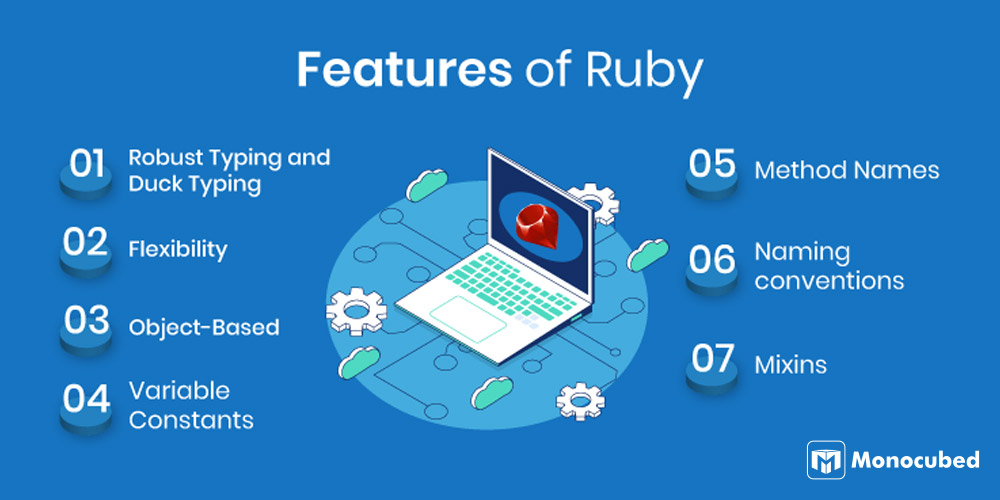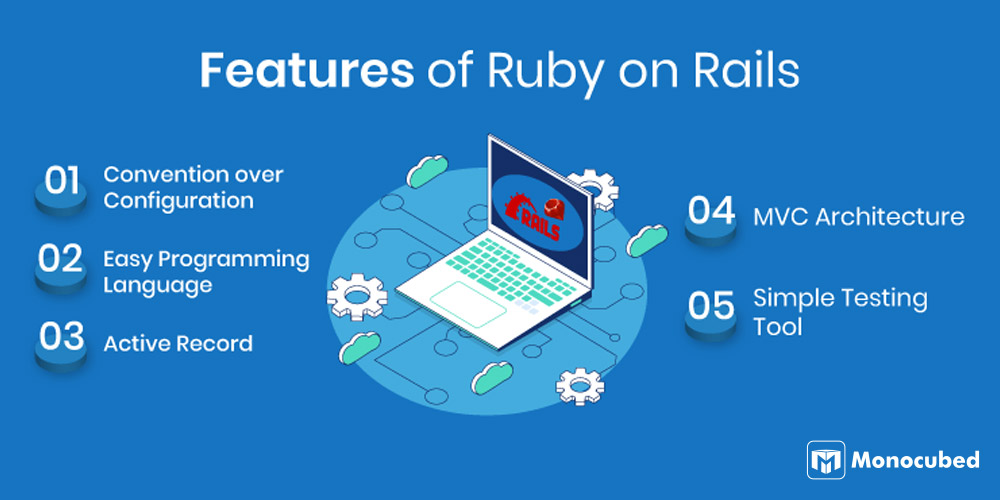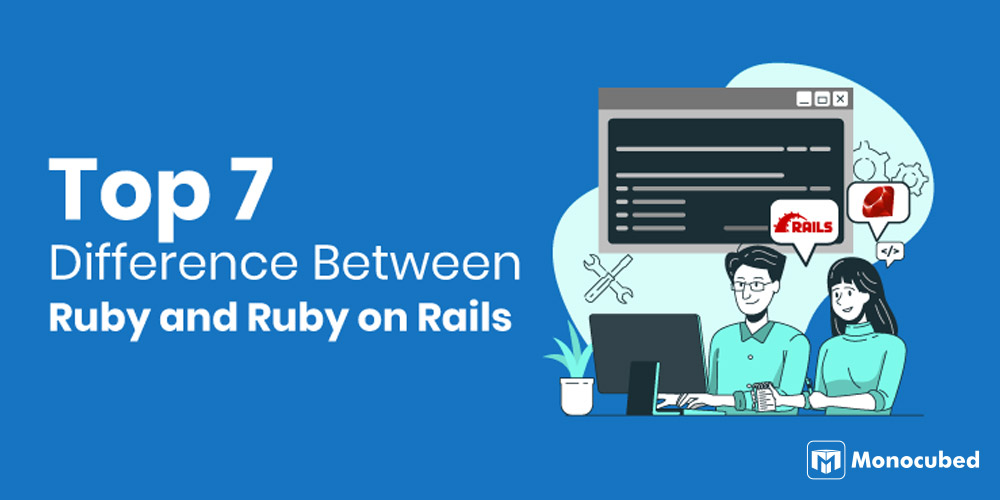In this digital era, we have numerous scripting languages and web frameworks that simplify web development for developers. How to find the right technologies for your particular project is the more important question today.
Around 2005, the interest in a programming language called Ruby hiked immensely. The reason? Release of a new Ruby development tool – Ruby on Rails web framework. With mounting usage of Ruby for websites, there is also increasing confusion between Ruby and Ruby on Rails.
It is important to understand the difference between Rails and Ruby before you use the techologies. Before you start your web project and hire Ruby on Rails developer, read this blog. You will learn –
- What is Ruby and what is Ruby on Rails
- The difference between Ruby and RoR
- Features of Ruby and Rails
- If Ruby and RoR are right for your project
Let’s examine in-depth these two technologies to avail a better understanding.
Table of Content
What is Ruby?
Ruby is an all-purpose programming language based on object-oriented notions. It is an elucidated language exercised to invent web applications at an elevated pace. Ruby is an open-source that is written in C language and is free. With a stable release 2.7.1, it is more composed and apparent, having a lucid sentence structure.
ts syntax is quite similar to Perl and its semantics are related to Smalltalk, but it varies significantly from Python. It supports manifold programming models, including object-oriented, functional, and procedural programming. To avail an analytical view on Ruby vs Rails, we must examine its characteristics individually.
Features of Ruby

Ruby is object-based, which means each value is an object, consisting of instances of types and classes that a lot of other languages delegate as primitives. Variables constantly seize references to the objects. Generally, Ruby seems to abide by the ‘Principle of Least Astonishment (POLA)’, which means that it must function in a way to diminish confusion for skilled users.
To understand it, let us have a look at its features:
-
Robust Typing and Duck Typing
Ruby is an exceptional open source scripting language, which turns out that their programs are not compiled. Rather, its classes, methods, and modules are stated and compiled when its code operates.
The variables in Ruby are effortlessly typed language, which determines that any variable can grasp any kind of object. While the method is called on the object, Ruby looks up at the name regardless of the type of that object. This is called duck-typing. It can permit you to create the classes that can profess to be another class.
-
Flexibility
Ruby is known to be a flexible programming language as you can simply redefine, remove, or insert existing active parts to it. It grants its users to liberally modify its parts as they desire. Due to its easy and clean syntax and garbage collection, it allows any new Ruby on Rails developer to study it very easily and quickly.
-
Object-Based
Ruby is basically an object-based language. Each value is an object and these objects have a class. Its code has its actions and properties. Also, Ruby is greatly influenced by Smalltalk programming language. The rules applicable to the objects are also applicable to the entire Ruby.
-
Variable Constants
Constants are not actually constant in Ruby. If any previously initialized constant will be altered in a script, it will merely activate a caution but will not close down your program.
-
Method Names
Here, the methods are approved to end with a question mark (?) or an exclamation mark (!). By assembling, the methods that respond to questions end with a question mark, and the methods that show that the method can alter the state of the object end with an exclamation mark.
-
Naming Conventions
Ruby is a programming language that designates some of its naming conventions for its method, variable, class, and constant.
- Constant: It starts with a capital letter.
- Method name: It is allowed to start with a capital letter.
- Instance variable: It starts with a @ sign.
- Global variable: It starts with a dollar sign.
- Class variable: It starts with a @@ sign.
-
Mixins
Ruby has a characteristic of a distinct inheritance. It contains modules as well as classes. A module encloses methods, but no cases. Alternatively, the module can be mixed into class, which inserts the method of the module to that class. It is somewhat related to inheritance but more flexible.
Want a Personalized Web Solution?
Get a custom-made web solution that is affordable, highly performative and easy to use. Talk to our team and start building.
A Brief: What is Ruby on Rails?
Ruby on Rails is one of the most popular web frameworks; built on a model view controller (MVC) pattern, supplying default structures for web services, databases, and web pages. Rails is a server-side application framework, which is written in Ruby under MIT License and created by David Heinemeier Hansson. Moreover, the comparison of Ruby vs Ruby on Rails would entail their key characteristics.
Theoretically, it is described as the package library known as RubyGem, which can be installed by utilizing the command line interface of an operating system.
It is an open-source framework, which facilitates Ruby on Rails developers as a time-saving choice to produce code. It has a compilation of code libraries, which present handy solutions for recurring tasks like developing forms, tables, or menus on the site. It supplies command-line scripts for performing snippets of Ruby code remotely.
It incorporates Ruby programming language with HTML, JavaScript, and CSS to build web apps that perform on web servers.
Features of Ruby on Rails

Many languages like HTML, JavaScript, SQL, and CSS, do not support both front-end and back-end. Conversely, Ruby is a programming language that encompasses both these ends and permits the developers to develop an inclusive web application. With its constant updates and stable release 6.0.3.1, Rails has reformed the web development planet through its realistic approach.
As a Ruby on Rails development company in Canada, we use the Rails framework in a variety of projects ranging industries, project size and functionality.
To know, ‘What is Ruby on Rails used for?’, let’s discover some of its features that provides various services:
-
Convention over Configuration
Programming in Ruby on Rails refrains configuration folders to spare reflection, conventions, and vigorous runtime extensions. The thought behind ‘Convention over Configuration’ is conveying value mechanically without any user involvement. Some of the software systems, consisting of Java web application frameworks, need multiple configuration files, all with numerous settings which becomes incredibly tedious.
This convention aspect amplifies productivity, as you do not require to allot time setting up configuration files. It saves your time that could have been spent on wondering about where the stuff enters and what names to allot.
-
Easy Programming Language
The Syntax of Rails is concise, simple, flexible, and similar to the English language which makes it easier to form your thinking and write it into a code. It aids you to compose simple commands in CSS, JavaScript, and HTML documents. It saves a lot of time and increases efficiency while writing lengthy and composite functions.
-
Active Record
Rails depend on a powerful library named Active Record, which makes it easy for developers to fabricate database interface queries. This happens because they write the query in Ruby, which is automatically transformed into SQL query, which gets the output and recovers an object. This active record library can complete almost everything; therefore, it is rare to form a query in SQL.
-
MVC Architecture
Rails follow a model-view-controller architecture, which is the most extensively utilized web application architecture. With such a pattern, Rails splits codes of varied functions, namely data layer, presentation layer, and preserving a resource layer. Hence, the developers who know other frameworks having MVC patterns can avail ease in implementing Ruby on Rails.
-
Simple Testing Tool
Rails, created by David Heinemeier Hansson, also renders a unit testing setup named RSpec, which is easy to understand. Because it is simple Ruby, you can employ it to examine functions imparted in an application by independently calling them.
Rails aids you to make sure that your application has been tested appropriately. The above features rightly depicts ‘What is Ruby used for?’ With its constant updates and stable release 6.0.3.1, Rails has reformed the web development planet through its realistic approach.
Also read: 8 Best Ruby on Rails IDE and Text Editors for Web Development
The Difference Between Ruby and Ruby on Rails
One of the most popular programming languages, similar to Java or C, Ruby is an all-purpose language, best recommended for its advantages in web programming. On the contrary, Rails is the software library, which broadens Ruby language. Let’s observe Ruby vs Ruby on Rails in detail:
| Basis | Ruby | Ruby on Rails |
|---|---|---|
| Principle | Ruby was built on the principle of user interface composition. | Ruby on Rails was built on the principles of convention over configuration (CoC) and don’t repeat yourself (DRY). |
| Programmed | Ruby is programmed in the C programming language. | Ruby on Rails is programmed in Ruby language. |
| Framework | Ruby is not a framework. It is a general-purpose programming language. | Ruby on Rails is a web app development framework. |
| Inspiration | Ruby took inspiration from Smalltalk and Perl. | Ruby on Rails took inspiration from Django and Laravel of PHP and Python correspondingly. |
| Applications | Ruby is used to build desktop applications. | For building web applications, Ruby on Rails is used. |
| Languages used | While building applications, JAVA, C++, and Vb.net are mostly used. | While building applications, XML, JavaScript, CSS, and HTML are commonly used. |
| Syntax | The syntax of Ruby is much related to Python and Perl. | The syntax of Ruby on Rails is quite similar to Python, Phoenix in Elixir, etc. |
Pros and Cons
After understanding the concepts and detailed comparison on Ruby vs Rails, let’s examine the pros and cons of each of this technology.
Pros and Cons: Ruby
Ruby is an open source programming language that is widely used for developing vigorous services and web applications. It has been an ideal option for the developers, as it offers the capacity of blending with other technologies. According to BuiltWith, Ruby holds third place if we talk about programming language usage distribution.
- Dependency administration: Ruby language renders a chief advantage of administering various dependencies. It renders a flawless way to obtain, operate, and implement them. Developers do not require to use any other class directories to reconcile with added dependencies.
- Instant gratification: Employing this language in Ruby on Rails, make the developers write codes for forming any large application within a stipulated time, in comparison to other prevalent programming languages.
- Memory management: The management of memory is one of the core benefits of Ruby, allowing its users to do it physically. While scrutinizing complex algorithms and using a data structure, developers find this trait to be very helpful.
- Shared changeable state: In spite of being object-oriented, each object is changeable in Ruby. Even its originals get an identical state which might yield software bugs that can go to exceptions till the end.
- Manifold programming pattern: Ruby assists multiple programming paradigms, which can be a benefit as well as a hindrance. The basis behind it is that developers can be confused to depict the codes while creating a module. This might produce complications in their development and they might require overcoming them independently; not in a single pattern, which might consume much of their time.
- Syntax complication: It is not sensible to ignore syntax issues, even if the interpreter disregards it due to its huge codebase. Sometimes these concepts get skipped and the developers might tend to avoid such syntaxes.
Pros and Cons: Ruby on Rails
In Ruby vs Ruby on Rails, the former aids in exercising diverse databases that split the process between two duplications. This, in turn, supplies services and performance augmentation for scaling. Its developers can notice dissimilar database support as an enhancement in constructing their app design.
- Cost-effective: Rails is an open-source structure, which means that you do not have to burn up cash on its structure. It allows you to include methods without any extra concepts, so it can save a lot of time and exertion.
- Secure tool: A few of the security points are included within the system and authorized too. Using Ruby on Rails facilitates a secure development lifecycle, which is a remarkable security assertion method.
- Versatile: If you hope to avail numerous clients for your applications, you must make sure that it can adjust to the necessity of your users. With such amazing features, this framework can make the most productive and versatile applications.
- Multi-threading: Rails facilities Multithreading, which states that if you are not careful, requests will be lined up at the backside of an active request. This can create issues in performance.
- Ambiguity due to convention: Apart from the benefits of convention over configuration for the beginners, it attached ambiguity amongst skilled developers. For instance, with the nonexistence of configuration files, there is no code, which reveals that the data from a class named ‘chapter’ is certainly saved to the table defined ‘book’.
- Boot speed: Most of the programmers who are working with Ruby on Rails furnish that the speed of boot is not up to the anticipation. Based on numerous dependencies and files, it needs considerable time to begin. Due to this, the performance of the developers gets affected.
Have a Web App Idea in Mind?
We’re Interested. Let’s talk. Get your idea validated by professionals and a personalized quote. For Free.
Evaluation: Ruby or Ruby on Rails
On observing Ruby on Rails vs Ruby, Rails render more rapid programming processes than various systems and dialects. Its structure makes it simple and quick to adapt changes while forming any application.
The big companies that use Ruby on Rails are Shopify, Zendesk, Github, Netflix, Airbnb, to name a few, are thriving in 2022. Rails is largely utilized due to its structure, which displays its key characteristics.
While comparing Ruby programming language to other available programming languages, it has a strong declaration of being open-source and object-oriented. It contains several appealing advantages and properties that cannot be ignored easily. Having such multidimensional traits, this programming language stands apart in the present age of flexible app development.
Frequently Asked Questions
Is Ruby and Ruby on Rrails the same?
No, Ruby is a language, whereas Ruby on Rails is a web framework written in Ruby. The former is dynamic, object-oriented, and an interpreted scripting language. The latter is an open-source website application framework that functions in Ruby.
Which is better – Python or Ruby on Rails?
On comparing Ruby on Rails vs Python, if you are aiming to build web applications, then consider Ruby on Rails. Its community is huge and they are always updated. If you are keener in developing applications, but would want to study a programming language that is more broadly applicable and capable of managing data analytics, then you may prefer Python.
Should I use Ruby on Rails in 2022?
You can utilize Ruby on Rails dramatically in different fields. Owing to the constant updates and stable release 6.0.3.1, RoR portrays a bright future. Ruby on Rails development companies empower their web applications, which is beneficial for both, start-ups and reputable enterprises. For example, like Groupon and Shopify, you can aim to form a new e-commerce project, or like Slideshare and Airbnb, you can revolutionize your platform.
Conclusion
Every technology has its own strengths and drawbacks. From the above differences between Ruby and Ruby on Rails, it can be seen that both the technologies have a dynamic pace in the industry. On quite a few specifications, framework or programming is meant to be observed for building the applications as per the needs of end-users.
If you prefer this framework due to its enormous characteristics, contact us and avail dynamic Ruby on Rails web development.
Being convenient, Ruby programming language is known as one of the chief programming dialects of the globe. The rising popularity of Ruby on Rails is a perfect answer to the most asked question, ‘Is Ruby on Rails dying?’ Both technologies are free of cost, open sources, and easily available.
Their sustainability has been supplied by huge documentation accessible on their official sites, online communities, and blogs.
 By Jeel Patel
By Jeel Patel



